Published
on 23
Dec 2011
|
All rights reserved.
|
|
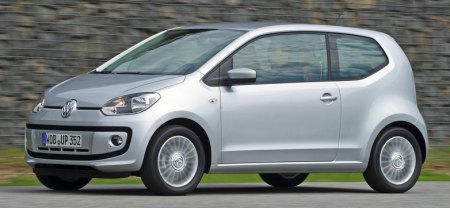
Volkswagen
group has an ambitious goal to be the world's no. 1 car maker by 2018.
That calls for extending its presence to all market segments. One of
the few segments that it has been underperforming is the
smallest A-segment city cars. Players in the field include Fiat Panda,
Renault Twingo, Toyota Aygo/Peugeot 107/Citroen C1, Fiat 500,
Toyota iQ, Smart Fortwo, Tata Nano and countless of Suzuki and Daihatsu
K-cars. Volkswagen last competed in the segment with Lupo from 1998 to
2005. It was not very successful because it lacked the practicality and
affordability that customers in the entry-level class demanded. In
2005, the Lupo was replaced with the Brazilian-built Fox. Spacious and
cheap it migt be, the Fox was built with
standards only developing countries would accept. Needless to say, it
sold
poorly in Europe.
Finally, Volkswagen got serious and started developing a
brand new car tailored to the needs of entry-level buyers. In the 2007
Frankfurt motor show, the Up concept car was displayed. It featured a
space-saving rear-engined layout and a compact but spacious body shell.
The styling was refreshing, and the best thing was that it did not look
cheap at all ! Very much like the original Beetle (also rear-engined),
it appeared to be classless.
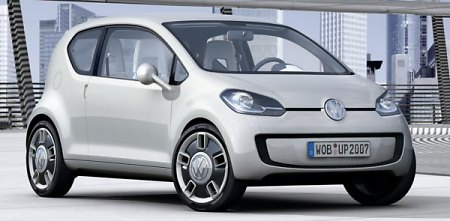
However, in the following development process VW realized the
rear-engined layout would demand many unique components, such as
engines, transmissions and suspensions. That would actually increase
production cost beyond acceptable level. Consequently, the production
Up reverts to conventional front-engined layout so that it can maximize
component sharing with other Volkswagen products.
We have no doubt that rear-engined would have given the baby Volkswagen
a unique character and an advantage in space efficiency, but to be
fair, Wolfsburg did a great job to limit the damage to the minimum.
Look at the production Up, you will be hard pressed to tell it has a
front-mounted engine. Its front overhang is virtually as short as that
of the concept, an achievement made possible by an
extremely compact engine. This is a brand-new, all-aluminum 1.0-liter
3-cylinder engine. Not only it is compact, it has the radiator
positioned beside rather than in front of the engine, saving
considerable space up front. On the flip side, the extremely short
engine compartment is
unlikely to accommodate a larger 4-pot engine in the future.
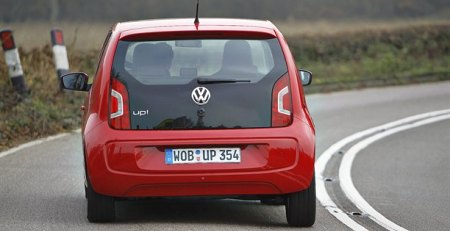
It goes without saying that a shorter engine compartment means more
space can be spent to wheelbase hence cabin space. The Up is 3540 mm
long, about the same as a Fiat 500, but its 2420 mm wheelbase is 120 mm
longer than the Fiat's. That puts its space efficiency ahead of any
European hatchbacks, just shy of some Japanese K-cars. On the other
hand, its 1641 mm width is much more generous than the K-cars' maximum
of 1475 mm. No wonder its cabin feels remarkably spacious for a city
car, with good legroom and shoulder room for both rows. It is capable
to seat 4 average-sized adults without much complaint. Besides, the
251-liter boot is
also large by class standard.
Such excellent space efficiency is also helped by a square, no-nonsense
shape. The Up is designed by Italdesign Giugiaro (before the latter
acquired by VW group). While it is not the most memorable small car
design by Giugiaro – that could be the original Fiat Panda, Uno or
Punto – it is unquestionably a high quality effort, blending Italian
cuteness with the typical self-restraint of VW. A few features
distinguish it from other small cars, most notably the large panel
covering its lower front grille and the kick of waistline near the
C-pillar. The black, glass-covered tailgate with C-shape taillights is
also a signature of the car. Similarly, the interior emphasizes a neat,
simple and function-oriented style. Its center console is mounted high
to ease access, while a wireless touch-screen sat-nav/multimedia device
can be attached atop the center console. Predictably, the dashboard is
made of hard plastic to save money, but it is nicely grained to look
high-quality. Moreover, the dash is dominated by a body-color-matching
panel to cheer up the ambience, while the door panels have their
exposed metal surfaces painted in body color as well, just like the old
Lupo. Overall, the cabin cannot match the more expensive Fiat 500 for
style and quality materials, but it trumps just any other rivals.
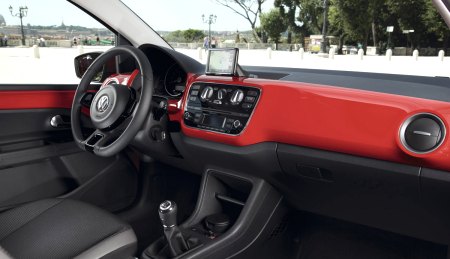
One thing I admire the baby VW very much is its combination of
lightweight and "big-car" refinement, something usually mutually
exclusive. The car weighs only 854 kg, but its suspension damps
beautifully on irregularities, and the engine, road and wind noises are
never intrusive. Part of this refinement must thanks to a well
engineered chassis that comprises of 17 percent high-strength steel, 39
percent ultra-high-strength steel and 8 percent hot-stamped steel,
which makes lightweight and high rigidity (a class-leading 19,800
Nm/degree) possible. To save heavy and costly insulation materials, it
uses a stamped acoustic firewall and optmizes the sealing of the cabin.
Structural damping is tuned to interact with other acoustic elements
and deliver a pleasant noise.
The EA211 three-cylinder engine is another example of sensible
engineering. To keep cost under control, it is not overloaded with
technology – just relying on 4-valves head and intake VVT to deliver
reasonable horsepower. A lot of weight is saved by using aluminum block
and by mounting the ancillary components directly on crankshaft instead
of mounting brackets. Weight saving even goes as far as eliminating the
usual balancer shaft. Then how does it deal with the first order
vibration typical to 3-cylinder engines? The answer is by using
lightweight reciprocating parts (pistons and con-rods) and swivel
engine mounts. The whole engine weighs just 69 kg.
Depending on ECU, the 999 cc engine produces either 60hp or 75hp. Both
have the same max. torque of 70 lbft. Predictably, performance is
barely adequate for the 75hp engine, while the lower power option could
be frustrating on highway. Fortunately, the engine is willing to rev
and reasonably refined. It does produce noticeable vibration at very
low rpm, but once it is up to rev the vibration is largely settled. The
5-speed manual gearbox is slick to shift, and it is well matched to the
torque curve to deliver a quiet operation in motorway cruising, at
least for the 75hp model.
As expected, the small car feels nimble and easy to drive around town.
Its
suspension setting is softer than the usual standards of VW, so it
displays noticeable body roll into corners. Compare with Japanese city
cars, however,
its suspension is firmer and body control is better. Highway stability
is also superior. The electric power steering is light and accurate but
lack of feedback.
Being a city car, the Up is very well judged. It is not only spacious,
functional, frugal and affordable, but delivers better quality and
refinement than most other city cars on the market. Nevertheless, next
to Fiat 500 we can't help feeling the VW is a little bit
bland, not just in terms of styling but also the engine and handling.
The most sensible purchase it might be, the Up still lacks the fun and
sparkles that the Italian is renowned for. |
Verdict:     |
Published
on 27
Jan 2018
|
All rights reserved.
|
|
Up GTI
|
|
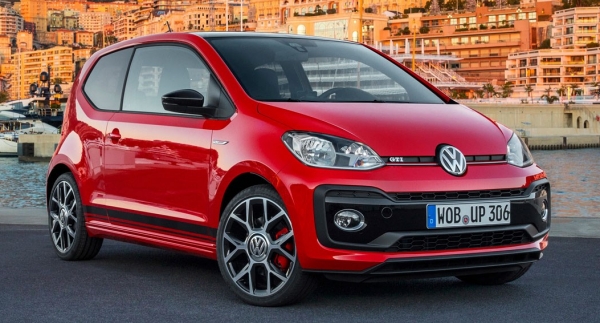
|
|
Shown
as prototype in 2012, why does it take so long to make production?
|
|
Volkswagen
has a long history of GTi. Even at the very entry-level, it once had Lupo GTi to please poor car
enthusiasts. However, the GTi version of the current Up city car takes
unexpectedly long to materialize – more than 6 years after the Up went
on sale. Why
does it take so long? Rocket science to develop the car? Difficult
business case to sort out? Lack of manpower? There is no reasonable
answer in my opinion. As early as January 2012, Volkswagen already
built a prototype Up GT and let many automotive journalists try it. Its
mechanical layout was basically the same as the ultimate production car
just launched: a 1-liter turbo triple-cylinder engine pumping out 110
hp and 129 lbft of torque, driving through a 6-speed manual gearbox to
the front axle, and the chassis got adequate rather than radical
upgrades. Some said the Dieselgate stopped its development as the
company directed resources and manpower to fix the big problem.
However, the Dieselgate did not broke out until late 2015 thus it was
unlikely to affect the production schedule. Maybe the top management
was just not interested in the pocket rocket that would bring little
financial benefits. How wrong it was! For some time Volkswagen’s
subcompacts were seen as dull and boring – think about Fox and the last
two generations Polo. It needs a really good GTi derivative to lift its
image and lure young drivers return. Anyway, late is better than never.
We are glad that Up GTi is finally showing up. Poor car enthusiasts
will
have another good choice beside Fiat 500 Abarth, Opel Adam S and Suzuki
Swift Sport.
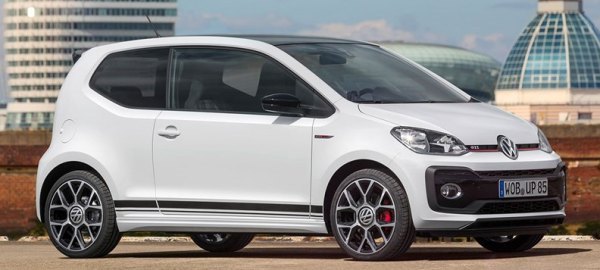
|
|
115hp
sounds a lot until you realize Ford manages to squeeze out 140hp from
the same capacity...
|
|
As mentioned, the Up GTi involves no rocket science. To keep cost down,
its modifications are quite modest in fact. Based on the existing
1.0TSI model,
the little EA211 3-cylinder turbo engine is given a larger turbo for
higher boost, while fuel injection and pistons are modified to cope.
Power is lifted from 90 to 115 horsepower, which sounds a lot until you
realize Ford manages to squeeze out 140hp from its 1.0 Ecoboost (see
Fiesta). Its 147 lbft of twisting force is remarkable, but I suspect it
is delivered on overboost, considering the peak power and torque don’t
match.
Anyway, in practice, the engine feels good. There is noticeable turbo
lag and little firepower below 2000 rpm, so it takes some patience, but
if you keep it on boil it will feel quite strong in the mid-range. It
is eager to spin to 5500 rpm, after which the power tails off until the
6000 rpm redline. For a three-cylinder engine, it is pretty good, if
not the best. The sound it produces is artificially enhanced by a
symposer (not digitized sound from speakers) which inducts some noise
from the engine intake to the cabin. When revved hard, it sounds
purposeful and sonorous.
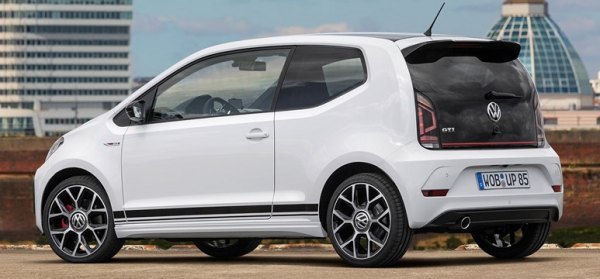
|
|
The
Up GTi has the agility only a small and light car like this could
achieve...
|
|
The Up GTi feels brisk enough as it weighs just under 1 ton. 0-60 mph
is done in 8.3 seconds, no match for the more powerful Fiat 595 Abarth
or Opel Adam S, but it is still a decent performance for an entry-level
hot hatch. Supporting the positive perception is the 6-speed manual
gearbox, exclusive to the GTi and not available to other family
members, as it offers slick and light gearchange.
At the chassis side, the modifications are predictable, i.e. stiffer
suspension setup, 15mm drop of ride height, quicker steering rack from
Polo, larger front disc brakes (though drums remain at the rear) and
17-inch wheels shod with 195/40 rubbers. The standard Up has always
been good to drive, so the GTi has taken it to a higher level. Its ride
quality is firm but the damping is well judged. It could feel harsh on
really sharp bumps in town, but on a regular B-roads it is absorbent
enough, rounding off surface irregularities and even potholes well.
Obviously, it doesn’t grip as hard or turn-in as sharp as a sportier
hot hatch like Ford Fiesta ST, but its body control and grip are well
matched with the power. The wheels are placed right at the corners thus
it feels well balanced in corner. The grip afforded by the narrow tires
are dependable because they don’t need to cope with a lot of power. The
steering is not full of feel but it is well weighted, accurate and
quick. Most important, the Up GTi has the agility only a small and
light car like this could achieve. It makes slow corners easy, fast
corners assured. The only thing it lacks is lift-off oversteer, which
is not in the genes of VW. Let’s face it, these days very few
manufacturers are willing to offer this playful idea.
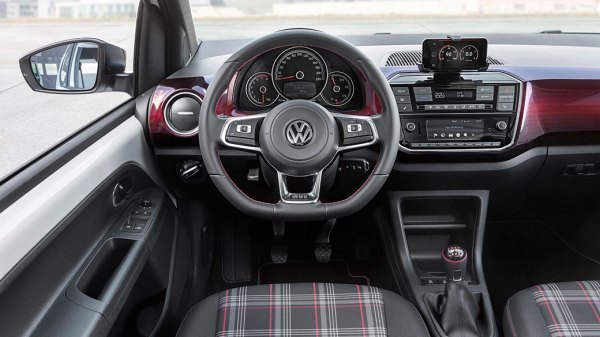
|
|
What
makes the Up GTi attractive is the overall package...
|
|
However, what makes the Up GTi the most attractive hot hatch in its
price range is not its engine or chassis, but the overall package. As
always, the Up is spacious, practical and its build quality is higher
than anything else in the class. The GTi has the latter enhanced
further with some smart styling tweaks, such as the new bumpers,
skirts, rear spoiler and side graphics, while its interior gets
tradition GTi upgrades, i.e. tartan cloth seats, some red inserts and a
flat-bottom steering wheel taken from Golf GTi. It is equipped with a
5-inch infotainment and Bluetooth connectivity to feel smart and good
valued. The rear seats are good for a pair of average-size adults,
something few A-segment cars managed. Moreover, you can have it in both
3-door or 5-door body. It is a well-rounded package with no obvious
weaknesses.
|
Verdict:     |
|